New adventures in beds and baths for spaceflight
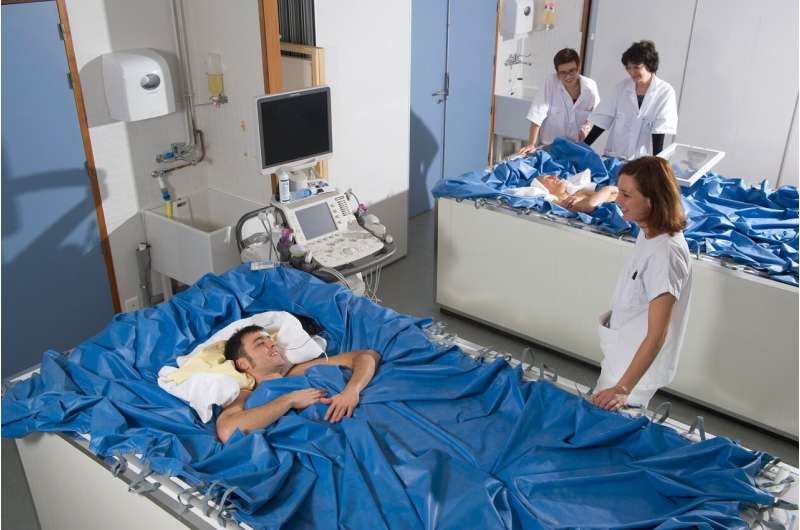
ESA is expanding its bedrest program that allows researchers to study how human bodies react to living in space—without leaving their bed.
In weightlessness, astronauts' bodies lose muscle and bone density, eyes change, fluids shift to the brain and more—our bodies adapted to life on Earth and are not designed for spaceflight.
Finding ways to stay healthy in orbit is a large part of human spaceflight research. The more test subjects the better, but sending people into space is expensive and hard.
Bedrest studies simulate aspects of spaceflight by placing volunteers in bed for long periods of time with their head 6° below horizontal. At all times one shoulder must touch the bed—meals, showers and toilet breaks included.
ESA has conducted many bedrest studies with Medes in Toulouse, France, and at the German aerospace center DLR's ':envihab' facility in Cologne, Germany. The space agency is now welcoming the Jožef Stefan Institute based in Planica, Slovenia, to conduct a new round of 60-day studies: one in Toulouse and one in Planica.
The Planica site is a fitting addition, since it is located at high altitude and there is less atmospheric pressure—much like a in future lunar habitat, which adds to simulation. The centre allows researchers to tweak environmental conditions, such as oxygen levels in the room. Testing volunteers in low oxygen levels, or hypoxia, is relevant for future space missions where the confined environment of spacecraft and space habitats could contain less oxygen.
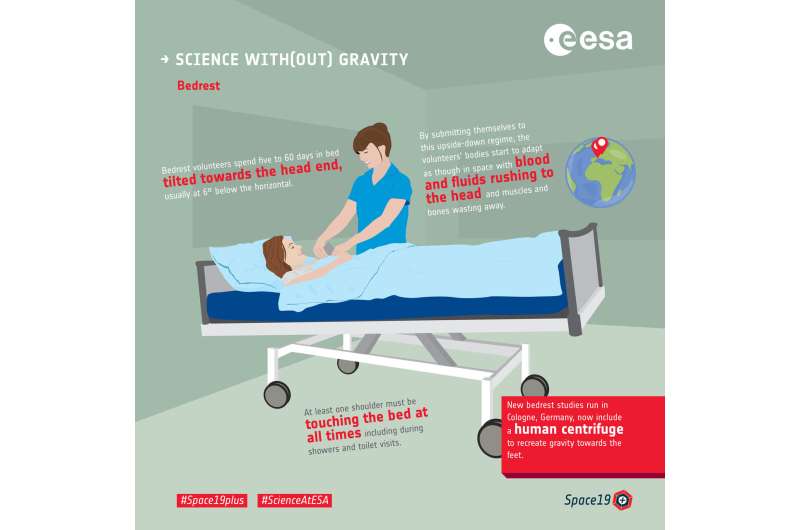
Each site in France, Germany and Slovenia has a centrifuge that can spin volunteers to recreate gravity pulling towards their feet while laying down. Artificial gravity could counteract some of the changes in the human body during space exploration.
"The goal is to definitively test measures that reduce the unwanted effects of living in weightlessness," explains ESA's science coordinator for human research Angelique Van Ombergen, "we have a long history at ESA of conducting bedrest studies and this round will put all our knowledge gained towards fine-tuning and working out the best techniques."
Special exercise machines will be mounted on the centrifuges. The effect of centrifuge spinning alone will be compared to spinning and exercise, and to control groups, to prepare for exploration to the Moon and beyond.
Researchers can submit proposals for experiments they would perform with the brave bedrest volunteers for the studies that will start in the next two years.
Water bed for dry immersion
In a first for ESA, another type of terrestrial study with Medes will use dry-immersion baths. Similar to bath tubs, containers will hold a total of 20 female study participants in suspension for five days each.
Dry-immersion studies benefit from placing less pressure on the body as volunteers are supported and suspended evenly in the tub, a condition that mimics the floating astronauts experience on the International Space Station.
"We decided to start our first dry-immersion protocol with all-women volunteers as there is almost no data on females," says ESA's human spaceflight team leader Jennifer Ngo-Anh, "we will not be doing any specific experiments for this first round, but we will collect data to better understand the dry immersion model and how the women react to assess these studies for more extensive investigations in the future."
Researchers can also apply to access data from the dry-immersion studies on our announcement of opportunities page.
-
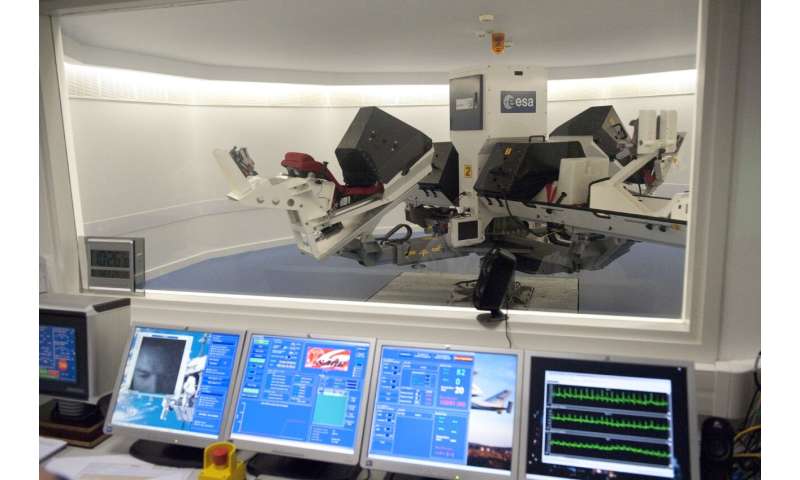
ESA's human centrifuge at Medes in Toulouse, France. The centrifuge that can spin volunteers to recreate gravity pulling towards their feet while laying down. Artificial gravity has potential to counteract some of the changes in the human body during space exploration. Special exercise machines can be mounted on the centrifuges. The effect of centrifuge spinning alone is compared to spinning and exercise, and to control groups ,to prepare for exploration to the Moon and beyond. Credit: CNES–Rachel Barranco, 2010 -
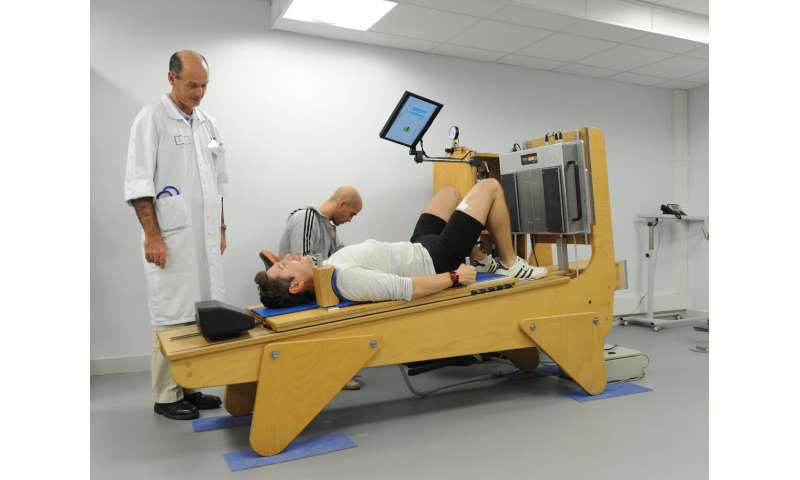
Medical staff at MEDES in Toulouse, France, prepare a resistive vibration exercise machine. The bedrest volunteer places his feet on the vertical plates and performs upside-down squats while the plates vibrate. To make the routine more intensive, the volunteer’s shoulders are pushed onto the plates with a force of up to 200 kg. Bedrest studies can answer questions on how our bodies adapt to living in space and on how our bodies adapt to growing old. Many of the findings from bedrest studies apply directly to people on Earth. Credit: CNES–Emmanuel Grimault, 2012 -
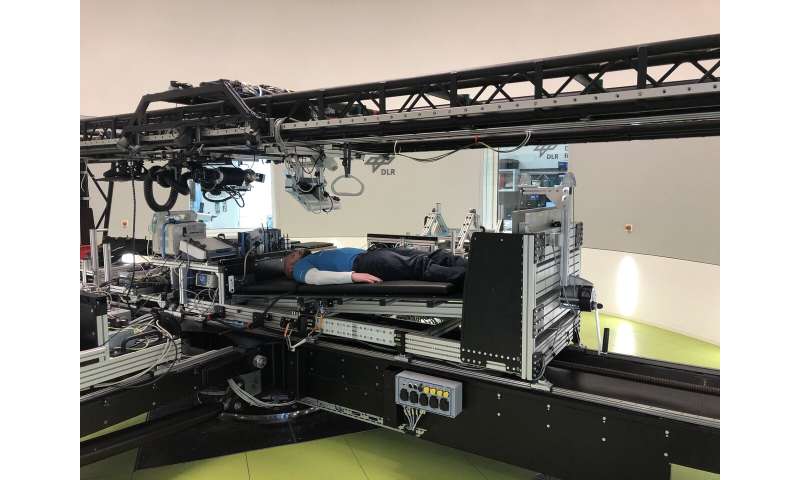
The short-arm centrifuge at the German Aerospace Center's (DLR) :envihab facility in Cologne, Germany will be used during the first joint long-term bedrest rest study commissioned by ESA and US space agency NASA to investigate the potential of artificial gravity in mitigating the effects of spaceflight. The study begins on 25 March 2019 and will run for 89 days. Test subjects will need remain in beds with the head end tilted 6 degrees below horizontal for 60 of these days to simulate the microgravity of space. Credit: CC BY-SA 3.0 IGO -
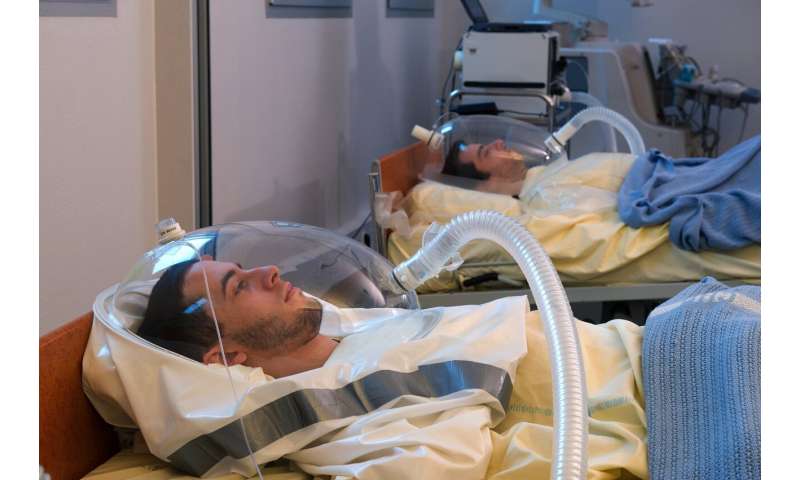
The masks are part of a system to estimate energy requirements. They measures how much oxygen is consumed and how much carbon dioxide is exhaled by the volunteers. These measurements allow scientists to get an idea of the relationship between food, the lungs and the energy consumption when at rest. The data are needed for an experiment in this ESA bedrest study held in Toulouse, France, in cooperation with the French space agency, CNES. The University of Bonn is interested in seeing if a high-protein, high-salt diet combined with exercise could combat bone and muscle loss and insulin insensitivity. Our bodies adapt to long periods spent lying in bed tilted 6° below the horizontal as if they were flying in weightlessness. Muscles and bones waste away and when a mission or bedrest campaign ends, the body needs many days to return to form. Studying this process on bedrest volunteers is a lot cheaper and easier than collecting information on astronauts. Finding ways to counteract negative effects to spaceflight is important for astronauts on long-duration missions as well as bedridden people on Earth. Credit: CNES-E. Grimault, 2013
"We get many requests to be a volunteer for these studies," concludes Jennifer, "but they are no joke, lying in bed sounds fun but the pleasure wears off very quickly—especially when blood is drawn and muscle biopsies are involved—we constantly salute the volunteers that sacrifice their daily lives for the benefit of human exploration!"
The organizations running the studies make their own announcements for bedrest and dry immersion volunteers. Follow their sites if you are still interested in doing your part for human spaceflight science.
The results from this type of research does not only benefit astronauts but has implications for people on Earth who are bedridden for long periods of time for example.
Provided by European Space Agency





















